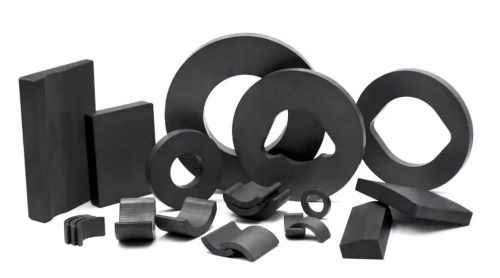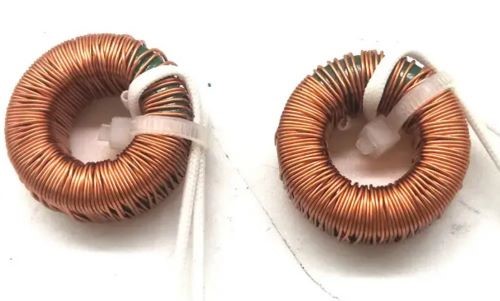Soft Ferrites VS Hard Ferrites
Introduction
Ferrite is a magnetic material that is widely used in electronic applications due to its high magnetic permeability, low electrical conductivity, and low eddy current loss. Ferrite materials can be classified into two categories: soft ferrites and hard ferrites. Each type has its own advantages and disadvantages. Here, this article is going to talk about the types, features, and applications of ferrite materials by comparing these two types of ferrite materials. Hope that you can have a better comprehension and select the perfect ferrites for your projects.
Properties of Ferrite Magnets
Ferrites are a type of common magnetic material containing iron oxide and other elements. Such material usually looks dark grey and has no metallic luster. The large concentration of iron oxide in ferrites forms a protective layer on the surface, so they could resist corrosion and erosion without extra coatings. What’s more, the magnetic strength of ferrite magnets is about 900 Gauss, and they can hold temperatures up to 250℃.

Figure 1. Ferrites of Different Shapes
Ferrites are characterized by exceptional features and various applications as well.
- Dielectric Strength: The electrical resistivity of ferrites is much larger than other metal alloy magnets, such as neodymium magnets, samarium cobalt magnets, and aluminum nickel cobalt magnets.
- Corrosion Resistance: Ferrite magnets stand out for their corrosion and heat resistance, which gives them the ability to withstand harsh chemical environments and moderate heat.
- Hard and Heavy: The iron oxide in ferrites is responsible for their high hardness, as iron is a relatively hard and dense metal. Their heavy weight, on the other hand, is due to a combination of factors including the presence of iron and other metal oxides. As a result, ferrites are usually used in large volumes for applications where a material with high mass is required, such as electromagnetic devices like transformers and inductors.
Related reading: A Brief Introduction to Ferrite Magnets
Classifications of Ferrite Magnets
Ferrite magnets can be divided into different types according to various classification standards. In terms of coercivity, these materials can be separated into soft ferrites and hard ferrites. Coercivity is an important factor to consider when classifying ferrites, as it determines the material's ability to resist demagnetization. Other factors such as production process and magnetic properties may also be relevant depending on the specific application. When we compare their production processes, we have sintered ferrites and bonded ferrites. Ferrites can be classified into isotropic permanent magnets and anisotropic permanent magnets as well. The former has weak magnetic properties but it can be magnetized in different directions, while the latter has strong magnetic power.
Soft Ferrites VS Hard Ferrites
--Soft Ferrites
Soft ferrites are typically composed of iron oxide and other metal oxides such as nickel, zinc, or manganese. These ferrites have a high magnetic permeability and low coercivity, which means they are susceptible to demagnetization. This property makes them ideal for use in high-frequency applications such as transformers, inductors, and other electronic components. Soft ferrites are also used in magnetic shielding applications, where they can help to reduce magnetic interference. You can find them applied to microwaves, radio antennas, and inductors as well.

Figure 2. High-frequency Transformer Coils
There are several kinds of soft ferrites. Manganese-Zinc ferrites are the most common type of soft ferrites, which are employed to make power, shielding, and linear inductive components. Nickle-Zinc ferrites have outstanding resistivity, and they are applied to manufacture RF transformers, pulse power modular, etc.
--Hard Ferrites
Hard ferrites, also known as ceramic magnets, are composed of barium or strontium ferrite and have a high coercivity and low magnetic permeability. This makes them much more difficult to magnetize and demagnetize compared to soft ferrites. Due to these features, hard ferrites are extensively used in applications that require a strong and stable magnetic field, such as in electric motors, speakers, and magnetic separators. Hard ferrites can be classified into strontium ferrites, barium ferrites, etc. Strontium ferrites find applications in small electric motors, telecommunication, micro-wave devices, and the electronic industry, while barium ferrites are utilized in loudspeaker magnets, etc. because of their stability in moist and corrosion-resistant environments.
--Comparison
Soft and hard ferrites differ in their magnetic properties and applications. Soft ferrites have a high magnetic permeability and low coercivity, which makes them ideal for use in high-frequency applications. On the other hand, hard ferrites have high coercivity, which makes them suitable for applications that require a strong and stable magnetic field. In addition to coercivity, their magnetic field strength is also different. Soft ferrites have a lower magnetic field strength compared to hard ferrites, which means they are more prone to demagnetization. In contrast, hard ferrites have a higher magnetic field strength, which makes them more resistant to demagnetization. The table below provides a clear comparison between soft ferrites and hard ferrites to help you better understand their differences. Table 1. Soft Ferrites VS Hard Ferrites
| Soft Ferrites | Hard Ferrites | |
| Composition | MnO · Fe2O3, ZnO · Fe2O3, Mn-Mg-Zn · Fe2O4, etc. | BaO · 6Fe2O3, SrO · 6Fe2O3, etc. |
| Features | high magnetic permeability and low coercivity; lower magnetic strength; | low magnetic permeability and high coercivity; larger magnetic force; |
| Applications | high-frequency applications; | transformers; motors; speakers; |
Conclusion
Overall, the choice between soft and hard ferrites will depend on the specific application requirements. Soft ferrites are best suited for high-frequency applications that require a high magnetic permeability, while hard ferrites are ideal for applications that require a strong and stable magnetic field. Understanding the differences between soft and hard ferrites can help in selecting the appropriate material for a particular application, ensuring optimal performance and efficiency. Stanford Magnets is a trustful supplier of a broad range of ferrite magnets. You can find quality ferrites in the shape of bars, blocks, discs, etc. Please check our homepage for more information.














